The design is directly inspired by the very detailed build of the Roubo (a French woodworker that published in the 1770 years an encyclopedia about woodwork : http://roubo.art/planches/tablePl_p1.htm) bench found when looking at how to use that lead screw in an appropriate way : https://t2woodworksplus.wordpress.com/2016/12/29/roubo-est-arrive/ (it's in French but Deepl is your friend and there are a lot of pictures, quite long but very rich in hand tooling use).
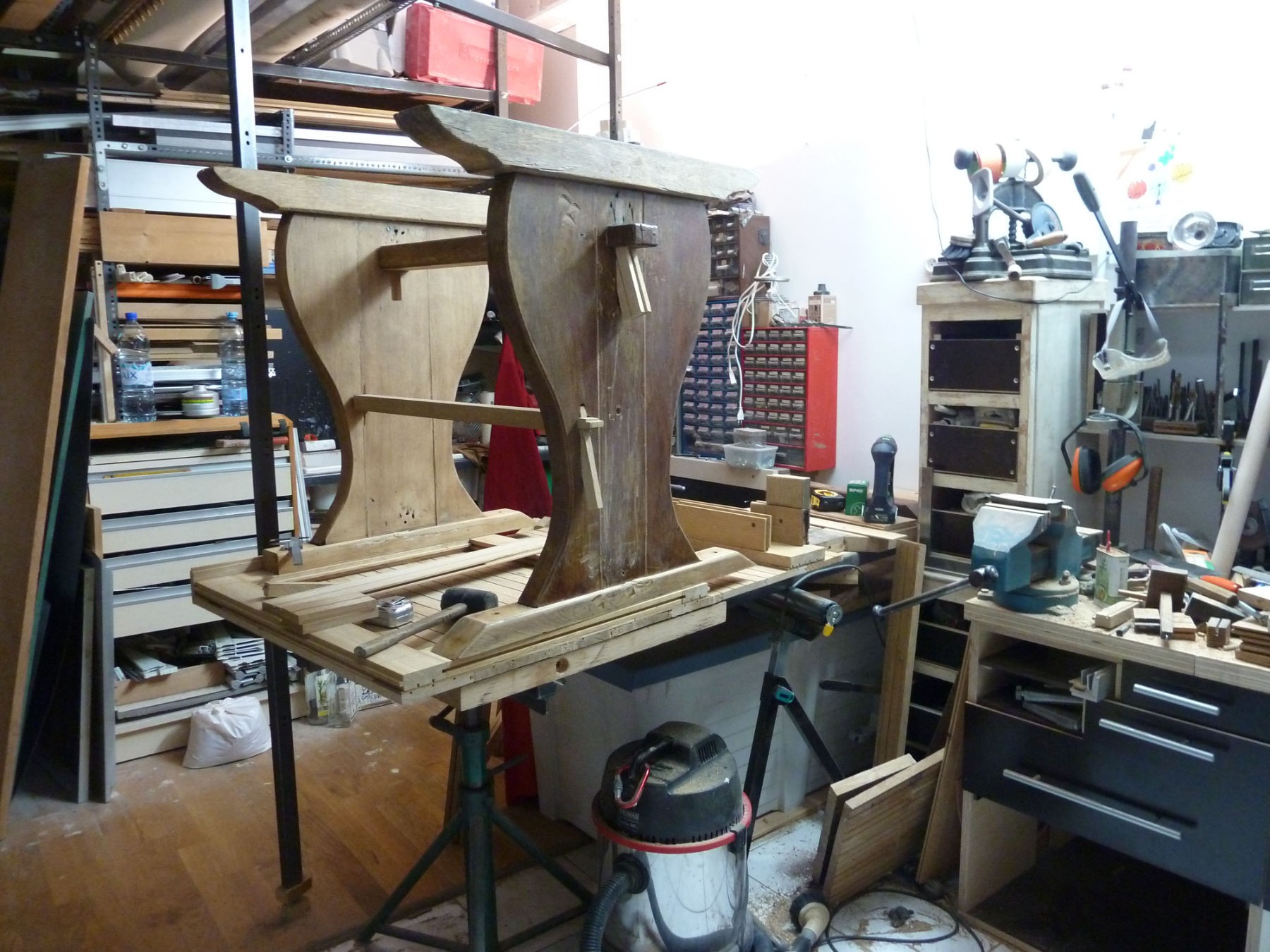
Lying on the back before its too heavy.
One of the legs had been sanded by the neighbor, the other one will stay that way.
The height of the bench is around 830 mm, I’m not a tall guy and it’s just the right size for me.
The top board isn't thick enough with the table top 40 mm only, I don't have big enough pieces of oak to make the 100 mm thickness required so its thickened with some 16 mm and 23 mm thick wood floor. 16 mm every where and some 23 mm under strategic places.
The 16 mm wood floor has been glued together to make a big strong board of the size of the hole bench and everything is screw tightened.
An additional mid height spacer between the legs is necessary for sturdiness and also to hold a shelf for stock storage.
The top part of the leg is 40 mm thick also, so the thickness of the final top plate is between 56 and 80 mm, good enough.
As I can't make it long enough, it will be 700 mm wide at one end, so the two original legs are on both sides of the width, with additional heavy twin legs in the middle, assembly of a lot of 23 mm wood floor and parts of a rustic 30 mm door (about 80 mm square full oak) : it will have to stand the vise strength, and two smaller legs on the smaller end.
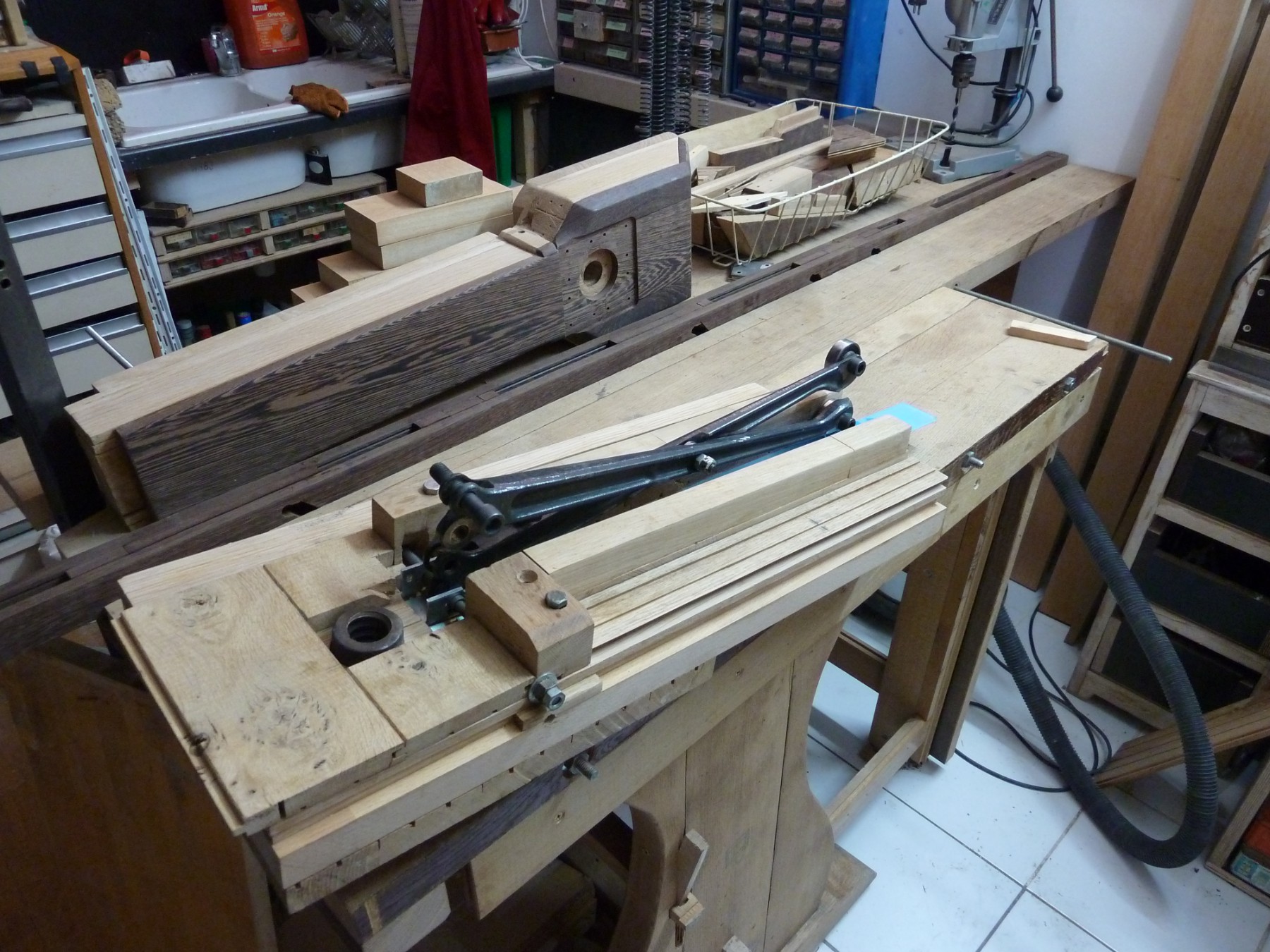
The front jaw of the press on the back, with wengue finish, the cross mechanism in front with the nut in place.
The center of the bench is occupied by a mobile wengue tool holding / woodwork stopper, it can be lifted like in the picture to give a good stop to a piece you're working on, or under, at the same height as the table top to give a full flat surface, it's been hand planned together with the top plate. Slots allow the (impermanent) storing of some tools. It slides on the 5 bolts that cross the table in the middle of the top board, with 45 ° angle grooves finishing flat.
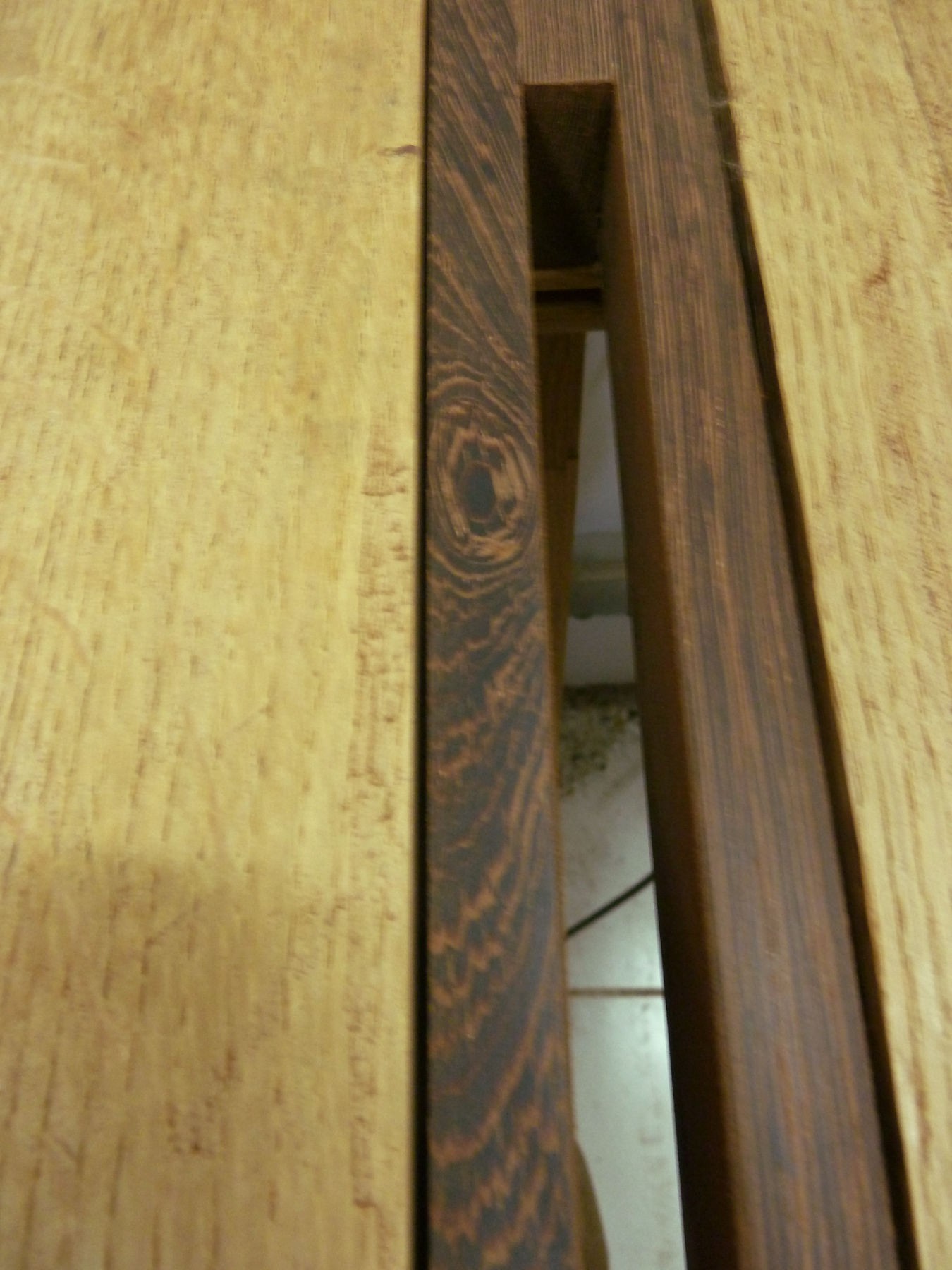
A (blurry, my workshop camera isn't top when the light is poor) detail of the center moving part, wengue's knots are so beautiful !
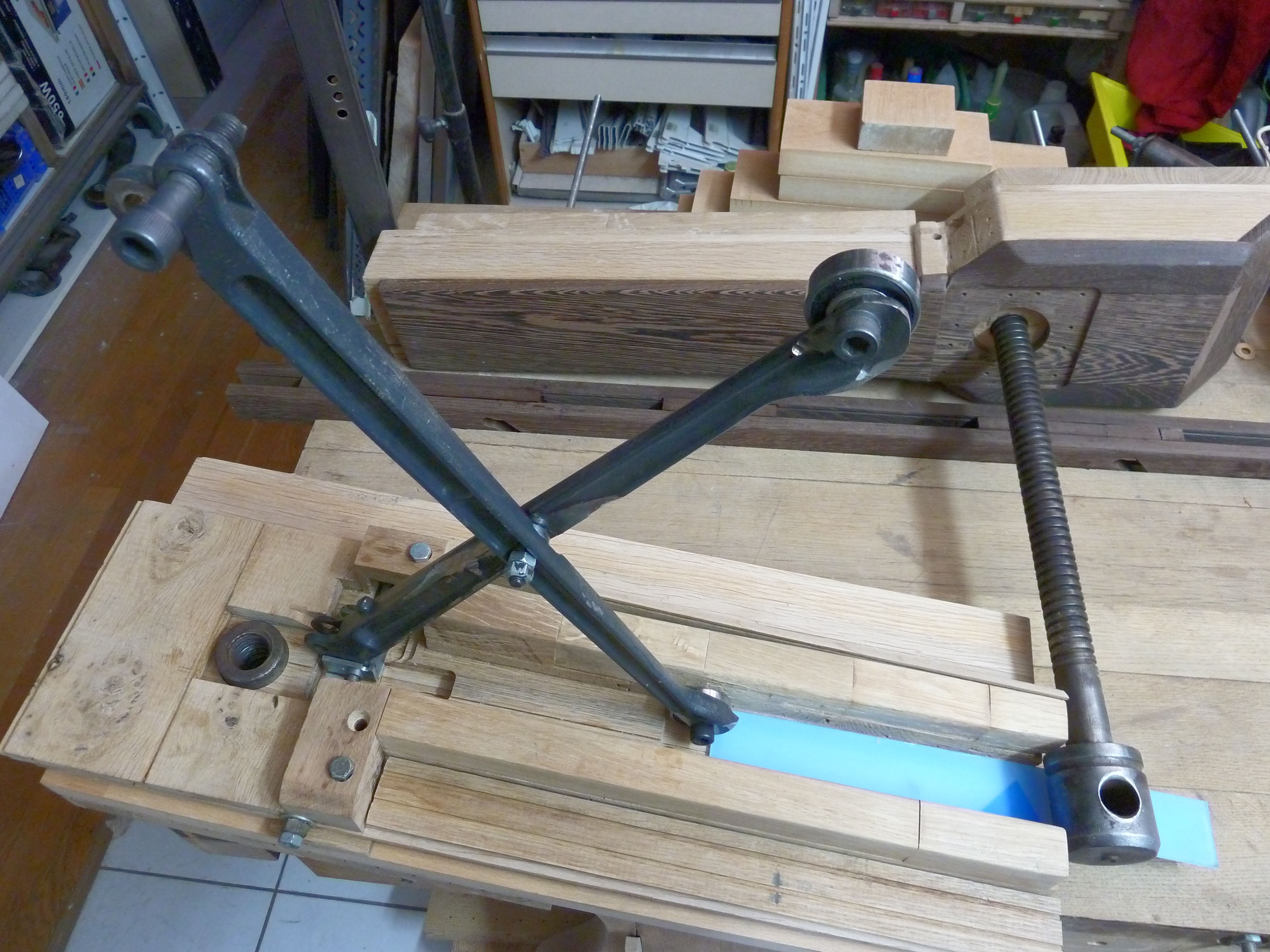
The cross mechanism is home made, a big bolt cutter in perfect shape has been sacrificed because drop forged steel was necessary to have a tight thing that will not bend under pressure (I still have a big bolt cutter, in worse shape, but it was too big for the need), and the simplest cross mechanism is sold 90 €, I had that bolt cutter for 10 €.
The two sliding ends have a big bearing to slip well, and there's a small one in between the two arms too.
Both front and back jaws are an assembly of 9 mm thick and 49 mm wide pieces cut from some plintes (the full size of the plinths is 68 mm but the the edges aren’t flat : one is rounded and the other has an angle, so it had to be reduced to 49 mm to have a square shape) glued together on an bigger central piece that was the link between the two legs of the table. Some pieces of a rustic 30 mm thick door recovered from an apartment left 30 years ago finally found a respectable use.
The front jaw is finished with some wengue recovered from another neighbor who changed the wood floor of his bathroom, it had been black tinted, so from the original 14 mm thickness it has lost around 1 or 2 mm after sanding, but that wood is so beautiful that I don’t regret the time spent on it to recover the natural color of the veins. And really don’t understand how you can buy such an expensive beautiful wood... and paint it black !

For the back of the rear jaw, a piece of 30 mm thick beechwood swedish brand kitchen counter top and two other 23 mm oak wood floor assortment had been used : the nut is going to give a lot of pressure when closing the jaws so it must be some solid stuff.
Of course I should have made the hole build in beechwood, just like the real Roubo ! Its fine grain is perfect for a bench because it’s hard, it doesn’t move with moisture and temperature differences and if there is an accident, as the chips are small, it’s located in a small area, oak have big veins and accidents can make much more damages (wengue is awful for that, very difficult to work with, and its splinters are a real pain), but oak was available for nothing and not beechwood, and it’s a beautiful hard wood too. I’ll try to be careful to avoid accidents.
And I’m very confident about the dryness of the woods used : the table was at least 70 years old and the wood floors around 20, so it’s not going to work as if it had been cut last year, in fact, after two years of using the bench, it didn’t move at all, although still not finished yet.

The cross arms are going to support an enormous stress, the screw is big, and also my determination when I want something to be held tightly in place, so I've been very cautious with the fixation system.
A 10 mm bolt goes thru a sturdy 14/18 mm bearing that's inserted in the bolt cutter's jaw holding holes, and everything is screwed on the back with two thick steel angle brackets, strong.
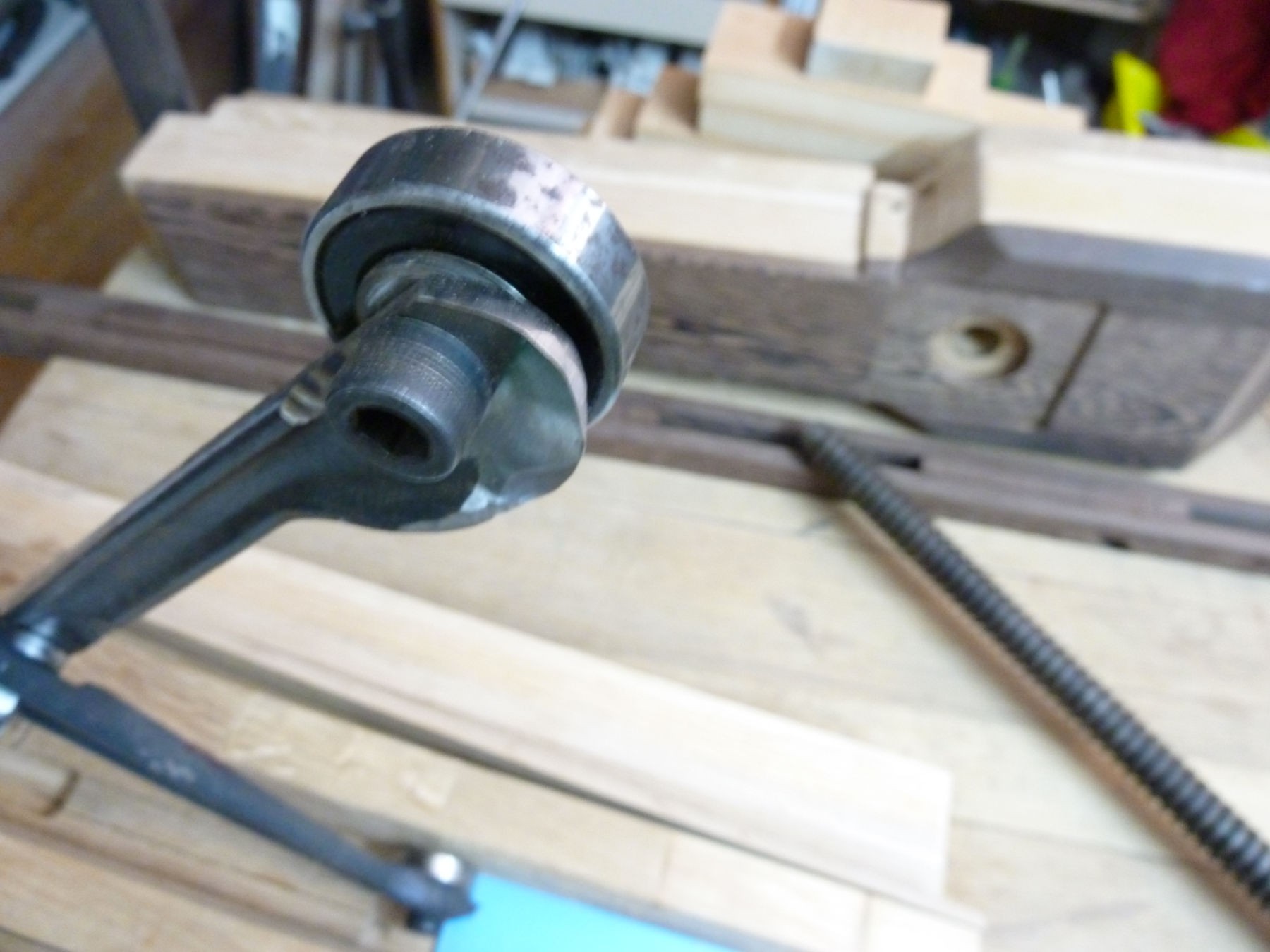
Detail of the sliding part of the cross, it's been a long time with the angle grinder to have a flat thing so the bearing an the bolt head are in a perfect angle with the bench.
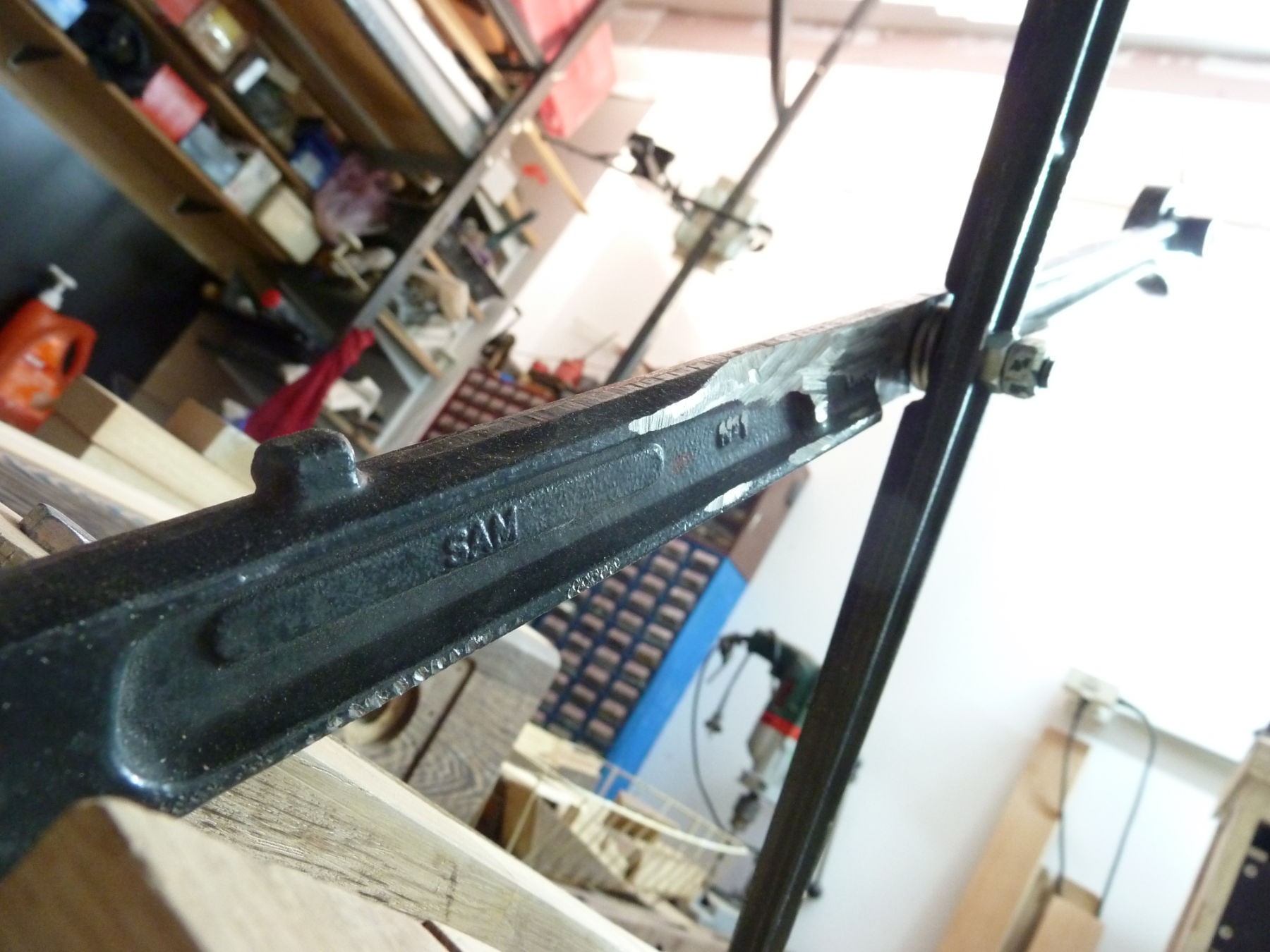
The grinder's also been used around the center to allow the needed liberty of movement.
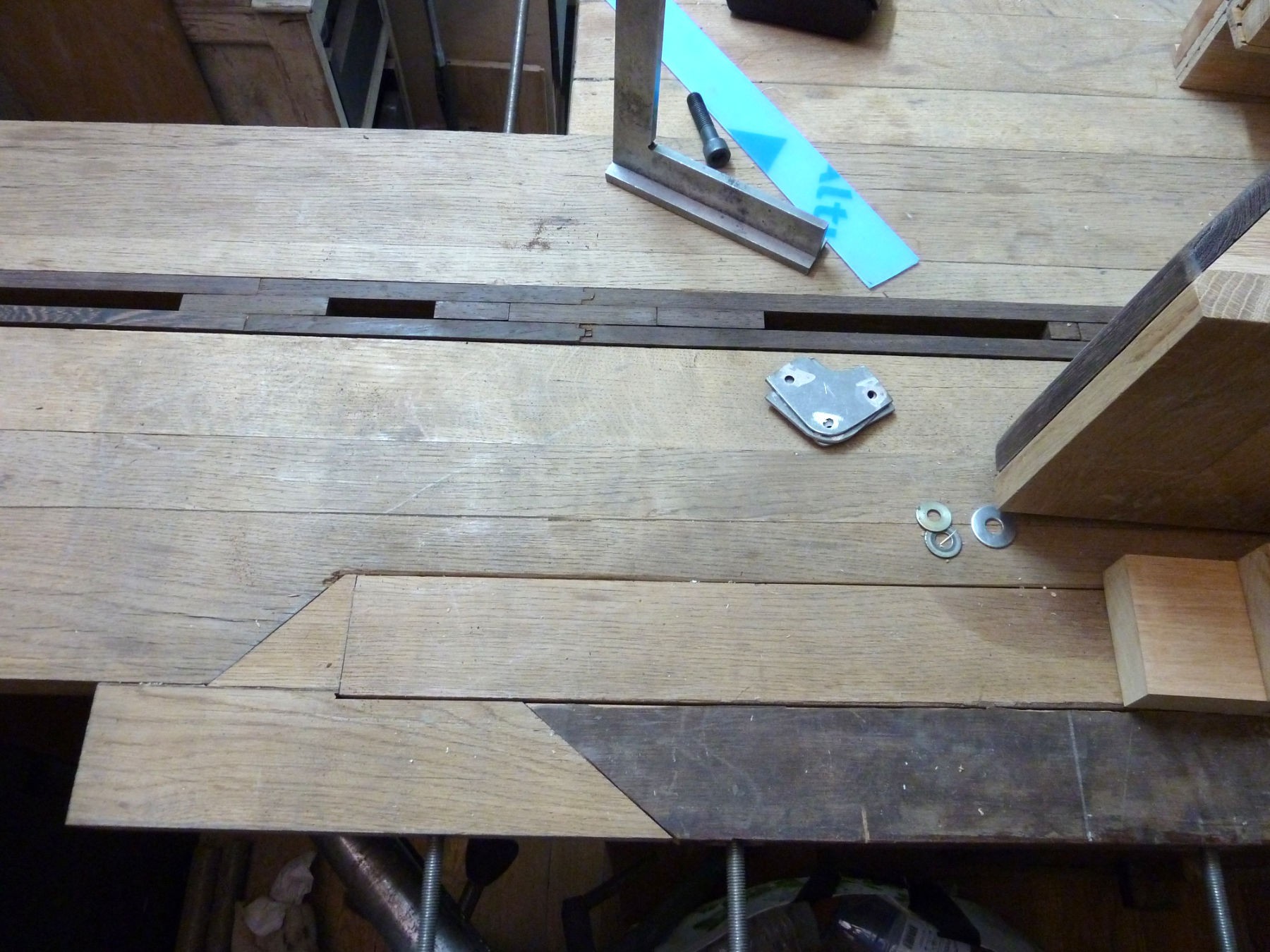
Here's the most " Frankenstein creature " part of the build, with all those weird angles cuttings here and there, it took quite some time for the smaller part to fit perfectly, but I'm happy with the result (even more after planning the hole top board of course).
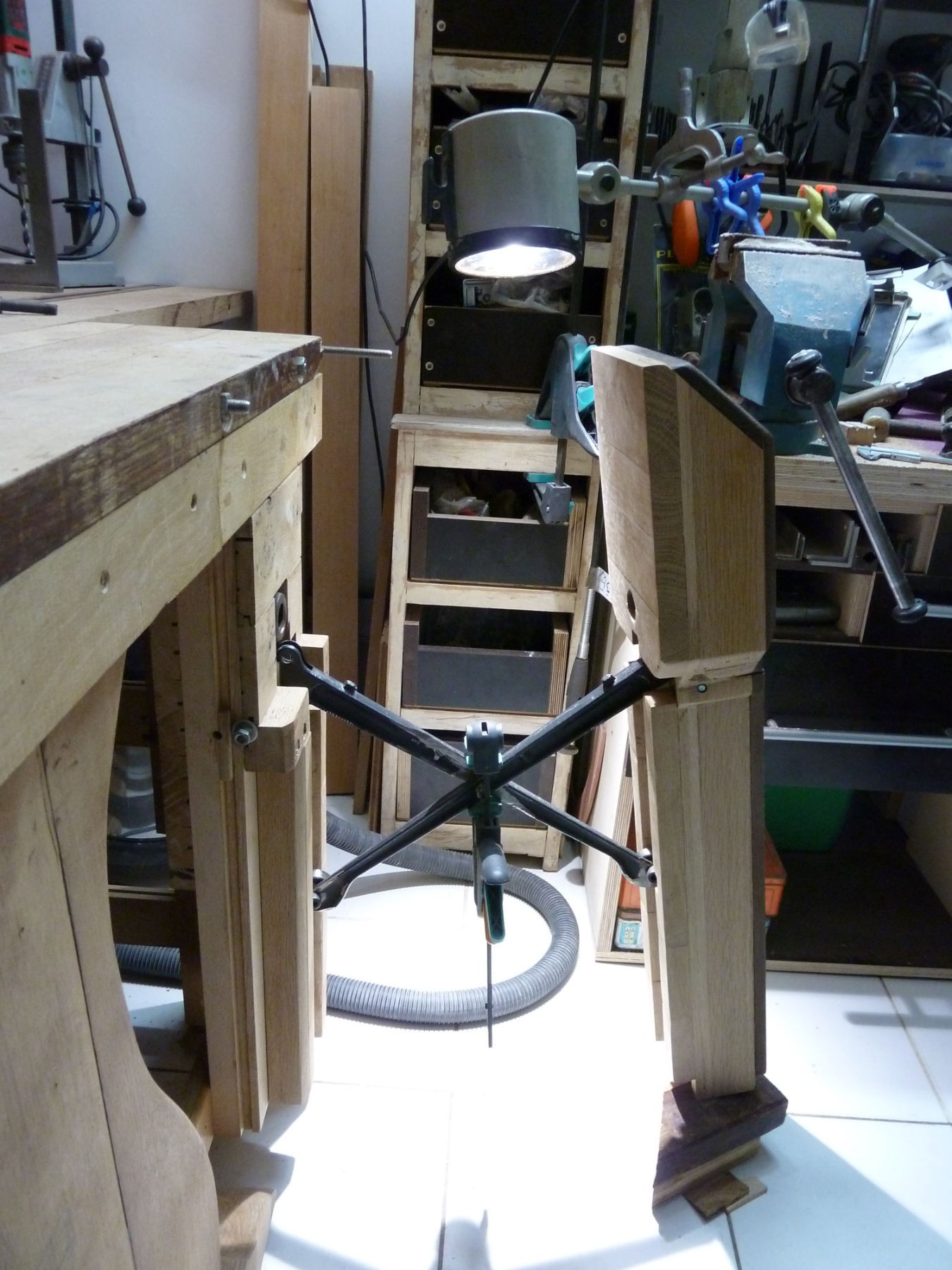
Big moment ! will it work ? I hopped so because the moving jaw is really heavy and it's not convenient at all to handle...
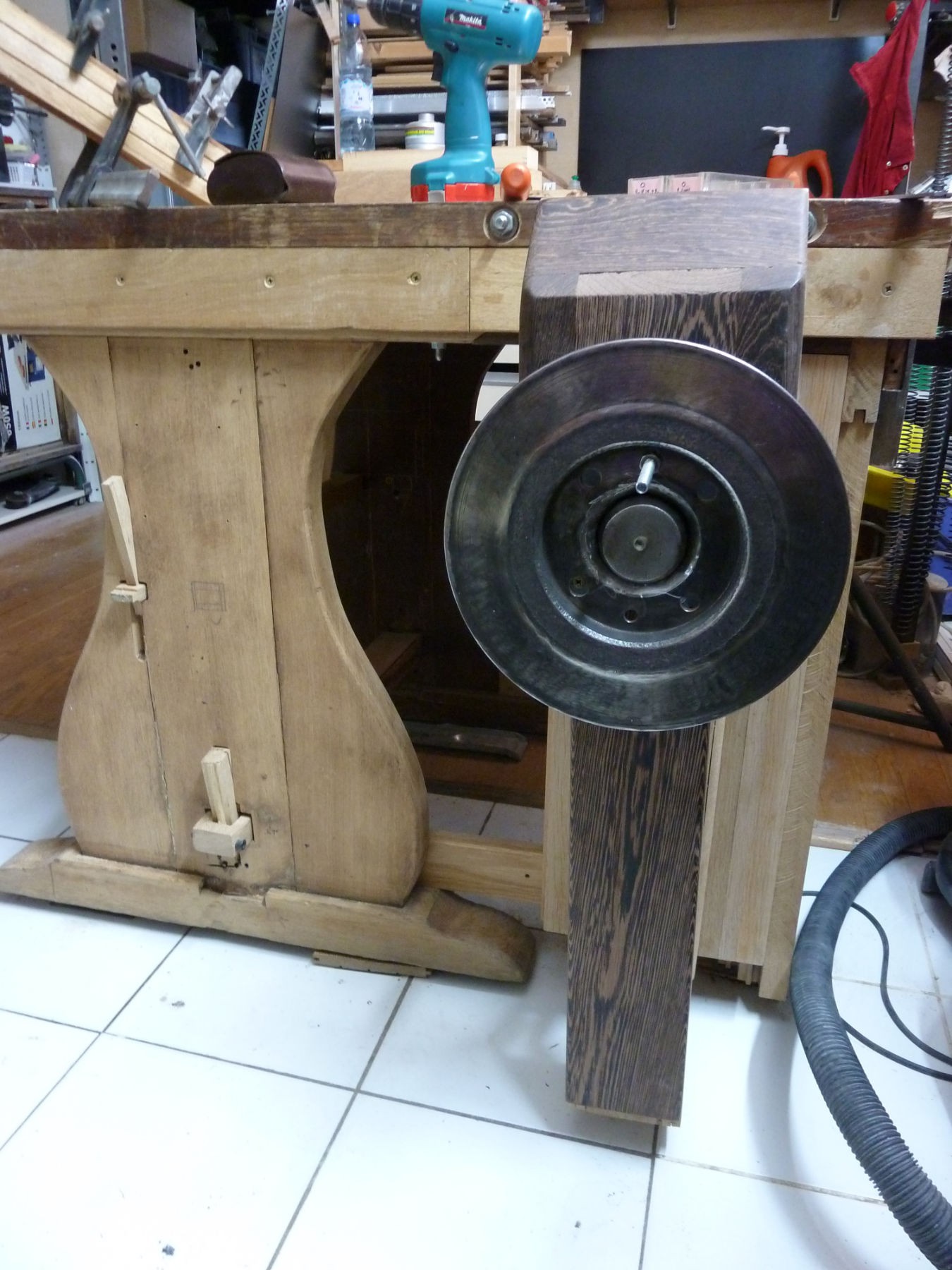
Yes, after adding a wedge it works all right !
There was a big wrought steel lever with the screw, but after seing videos of benches with a wheel, I wanted one, so that disc brake, after a long sanding (it was completely corroded) is a perfect wheel, it now needs a handle. The sic brake had been traded with a neighbor (another one) : I gave him a brand new car clutch mechanism (given to me by another neighbor), and he gave me that rusted bigger piece of steel. He's going to make a foot (stand ?) for a light out of it.
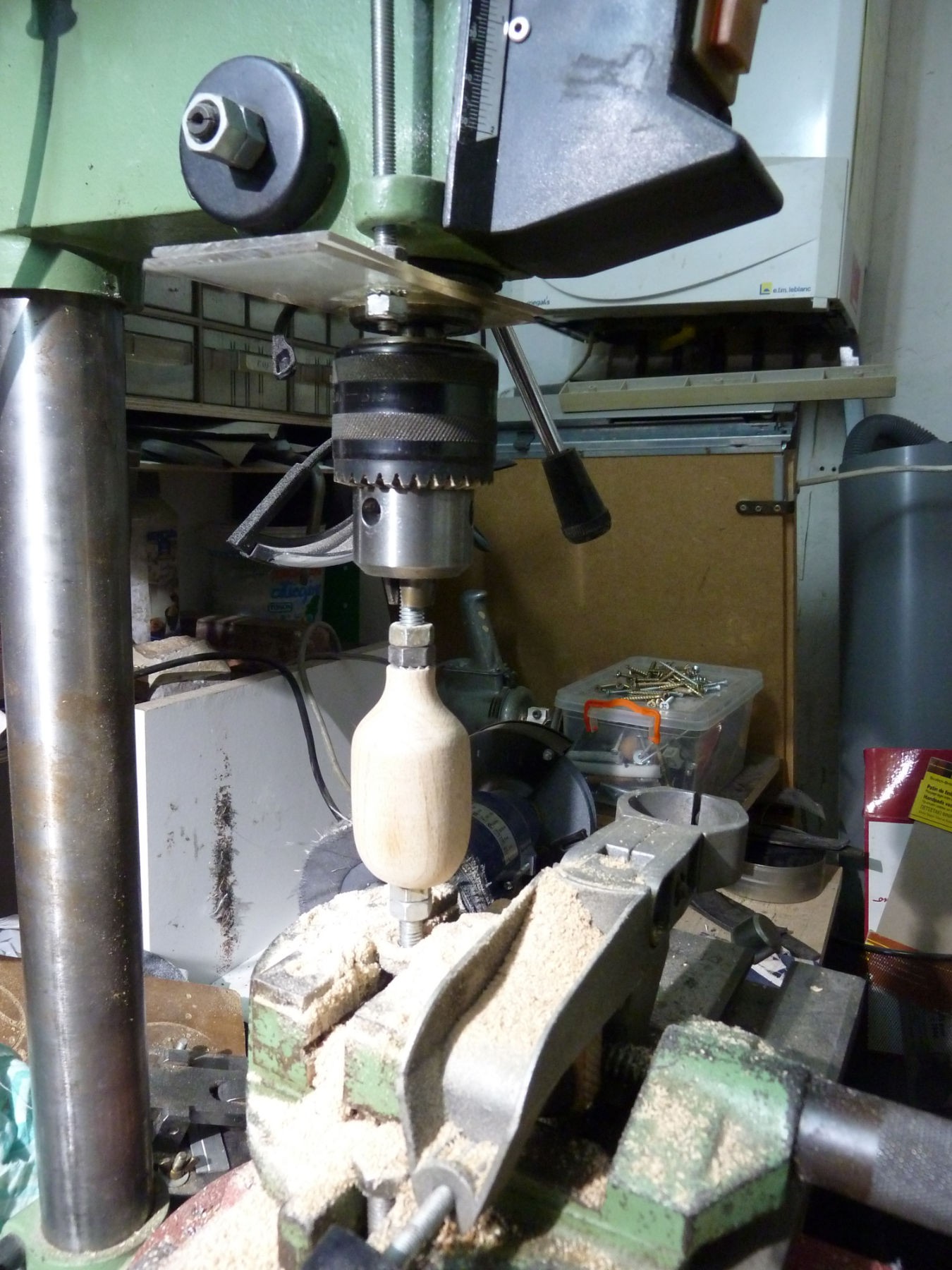
The drill press used as a lathe with a roller bearing in the vise, from a round 50 mm beechwood.
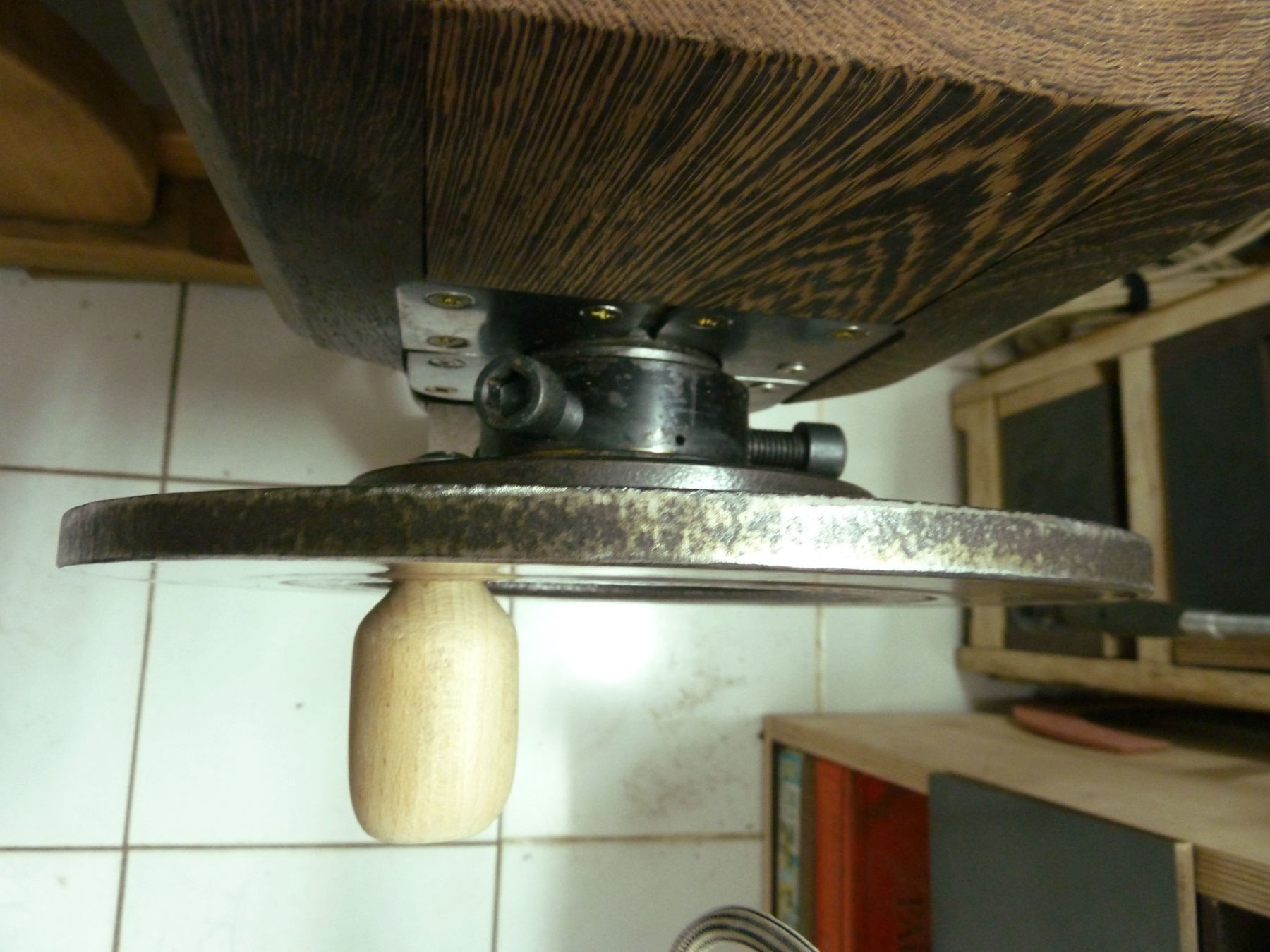
The wheel is tightened on the lead screw with a welded cylinder part of an Angénieux optics precision adjustment rig, and 3 M 14 (18 ?) bolts as I didn't want to modify the lead screw head.
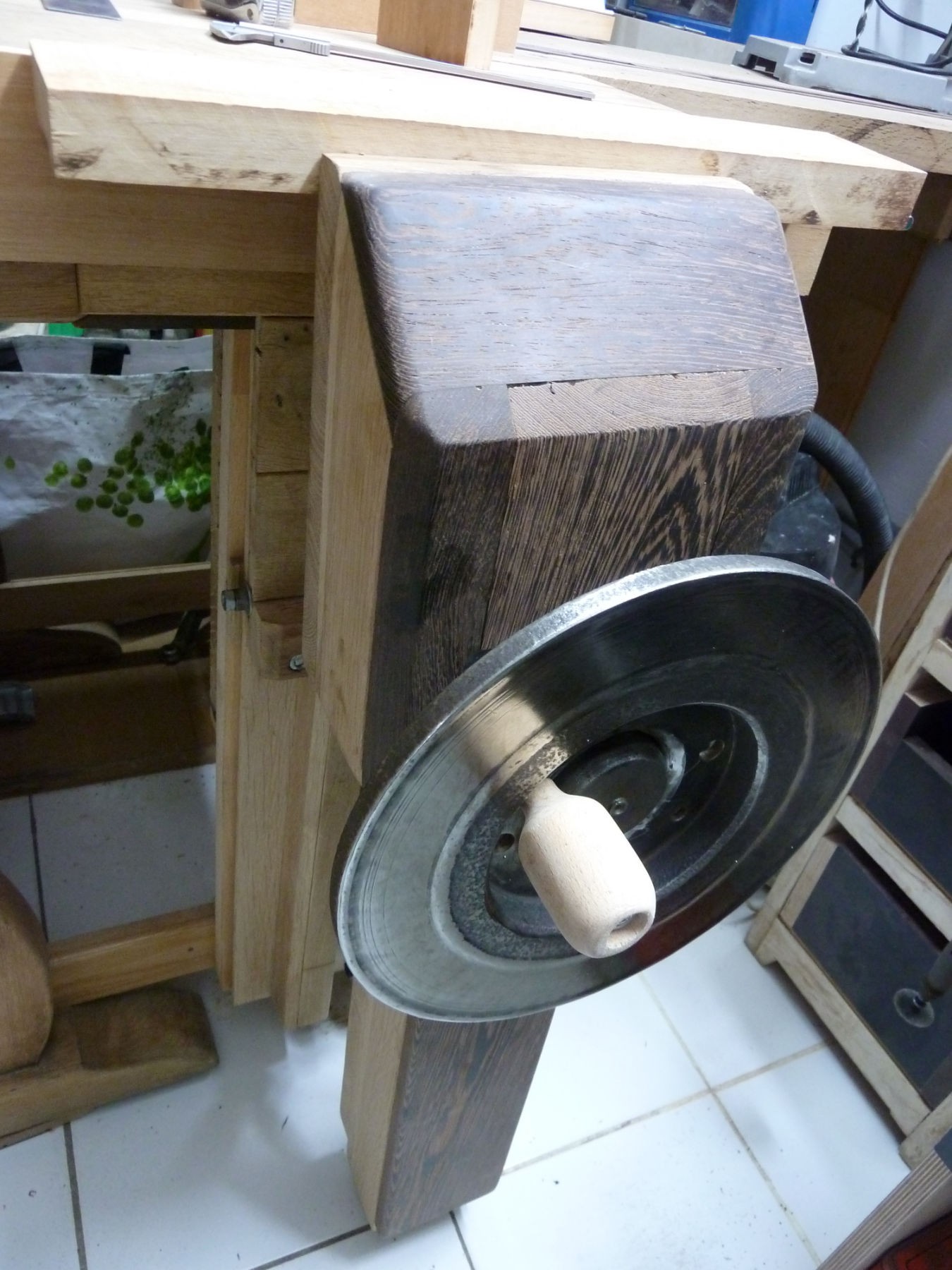
I'm very happy with it, the movement is very fast after a difficult start (there's weight to move) but, certainly due to the fact that the screw's not anymore perfectly strait, it slows when the jaws are closer, its harder to move and you need both hands to have a good grip of the work between the jaws.
And yes, it's not perfectly leveled, the moving jaw is a little bit upper on the right, good for big parts, but small pieces of wood are difficult to hold tight with the good angle to work (flat), never mind, big jaws are for big parts.

From the side, it looks great.
You can see that it has a notch ;o).
In fact the metallic rod is a leg of an up storage rack for long things, and it must be there to stand the weight.
And before the bench, people where always hitting it with their feet, arms and any other parts of their body.
The bench cannot be anywhere else in the shop.
So the bench now protects that important leg from being assaulted by un knowers (sometimes, mainly in winter time, some neighbors come in the shop to drink and smoke if its raining outside, most of the time, they are not really invited, and I have to make a break, whatever I'm doing, to drink with them, and then the day is over) and I feel relieved, reassured : there's a lot of weight up there !
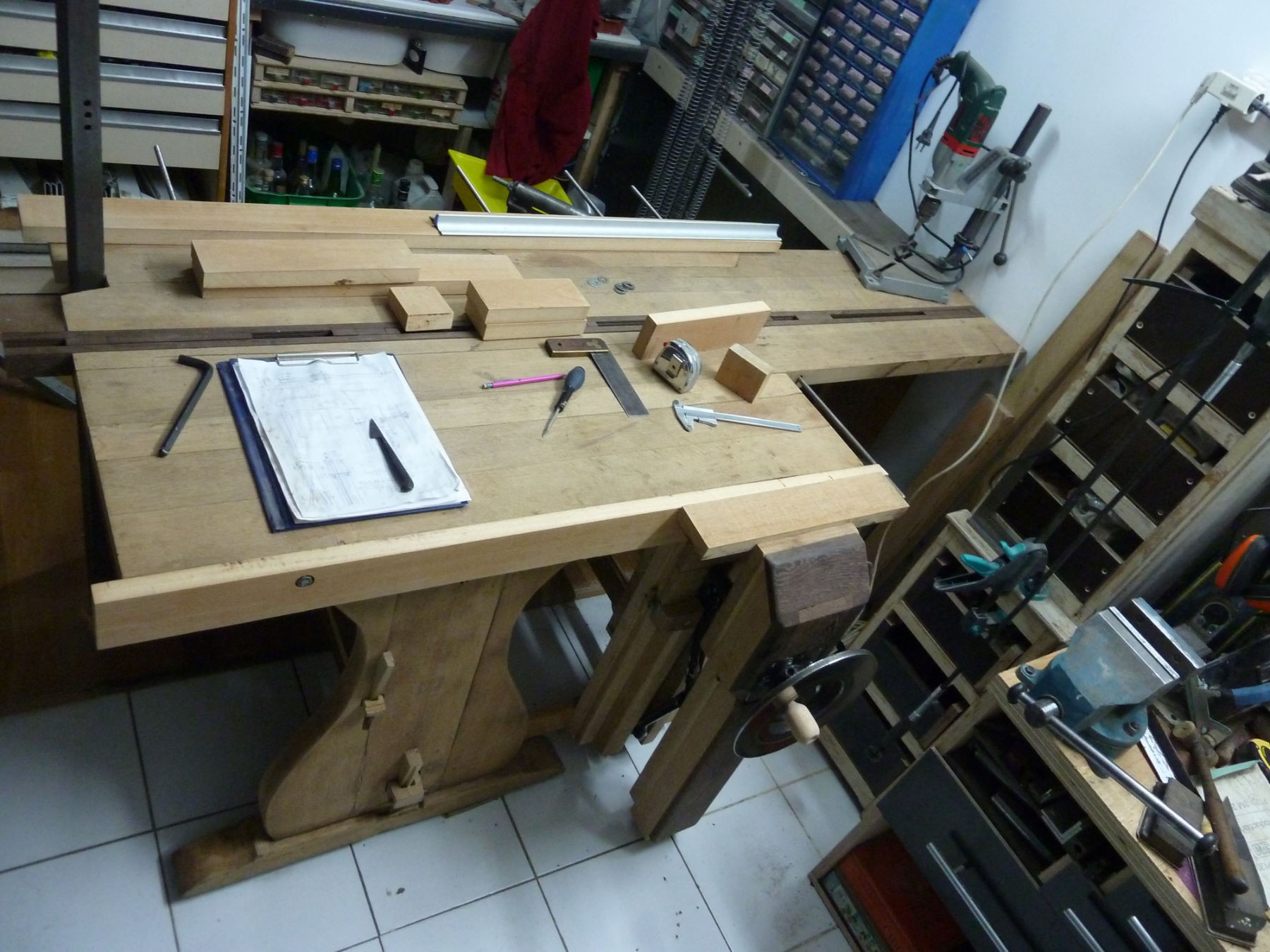
And from the top, it has a little bit the shape of an aircraft carrier ship.
The wood lying on the bench and on the front side (the belt) has been cut from a very nice 30 mm thick ruff wood board that was written SINGAPORE on it, I don't even know how that beautiful wood came in my workshop, neither it's name, but it makes very long soft chips with the plane. Surprisingly, the board had exactly the size needed to cut the whole surrounding of the bench (the 8 parts of the belt), with an 80 mm width, except on the wall side, the smaller end that's anyway not visible.
The belt isn't finished yet, the complete lockdown was only two month for me as I had to go back to work.
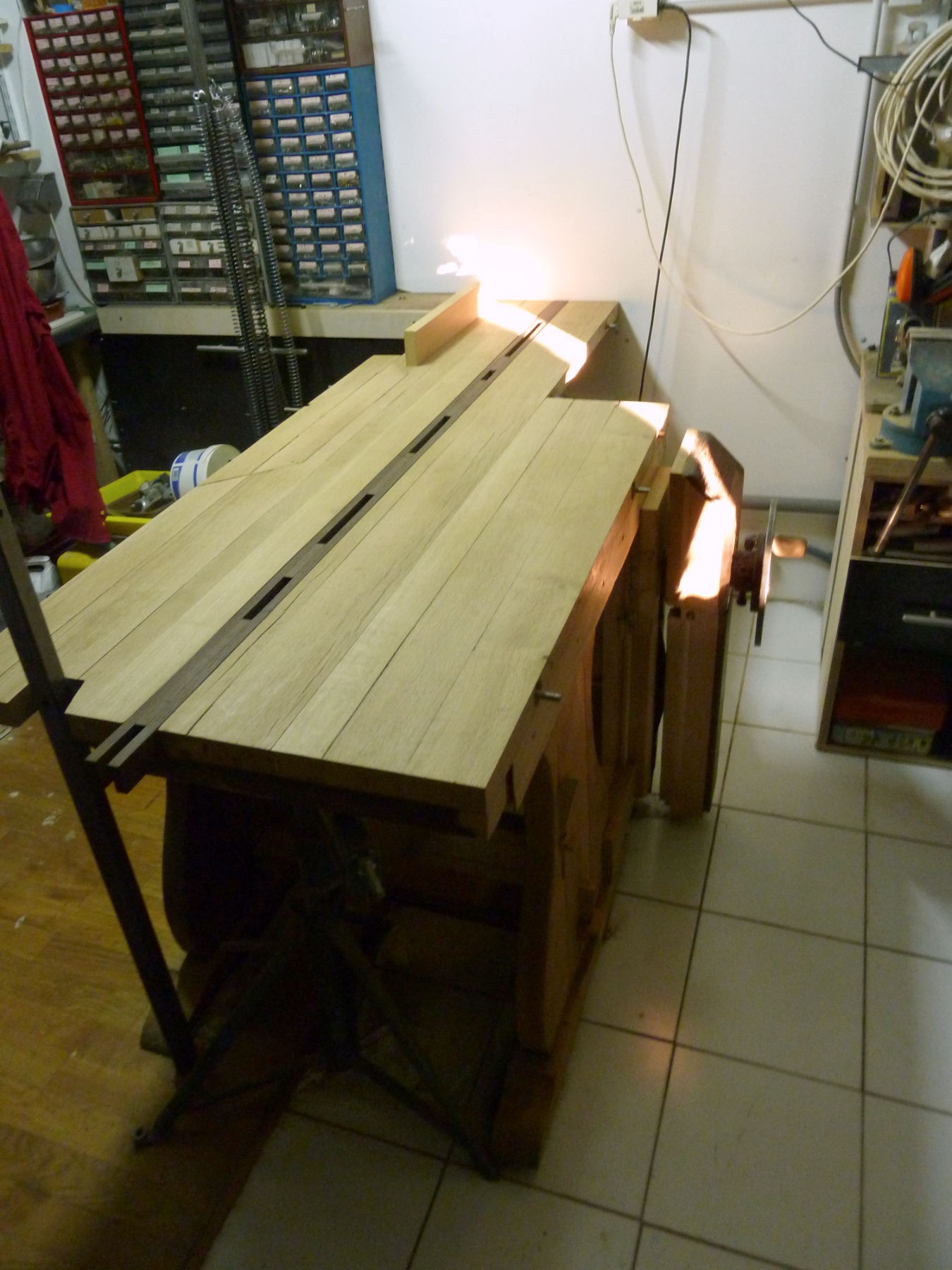
After some days of hand planning, with a long plane and the help of an aluminium square tube with a paper pen to mark the highs and downs of the old table top. A rare sunbeam in the workshop, it's nearly perfectly leveled, its still maybe 1 mm deeper in the center but I'm ok wit that.
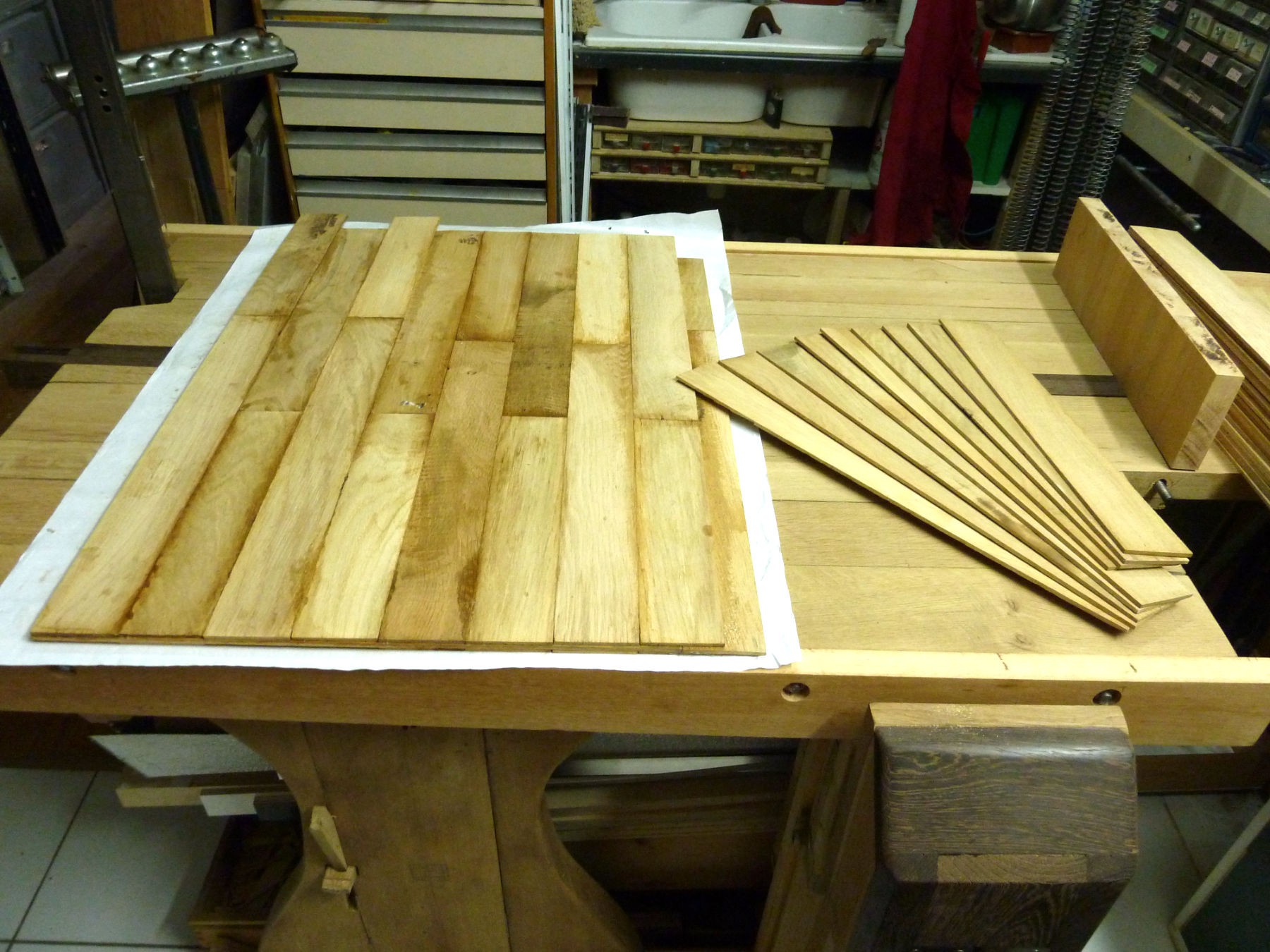
I wanted some shelves under the smaller end of the bench, no more big pieces of oak, but a lot of these 4 mm thick 65 mm wide and 450 or 500 mm long boards that where used for the packaging (to have cubic shape palettes, easy to wrap) of some oak wood floor ordered 19 years ago (they're quite dry now) and never used because it's mainly discarded pieces with small faults or defects or aubier (sapwood).
It's improper for any use because it's not so good parts of the wood, and it's too thin, but by making a glued assembly, it's plain oak plywood !

A stack of 3 looks hard but I wanted another layer, with another angle, to give more strength, and for the look too.

So here are my two shelves, cut at the right size and sanded, with another angle layer (16 mm is rigid enough, it won't hold heavy things), I know, that plywood is better with an impair number of layers, but 5 is too much material for the need.
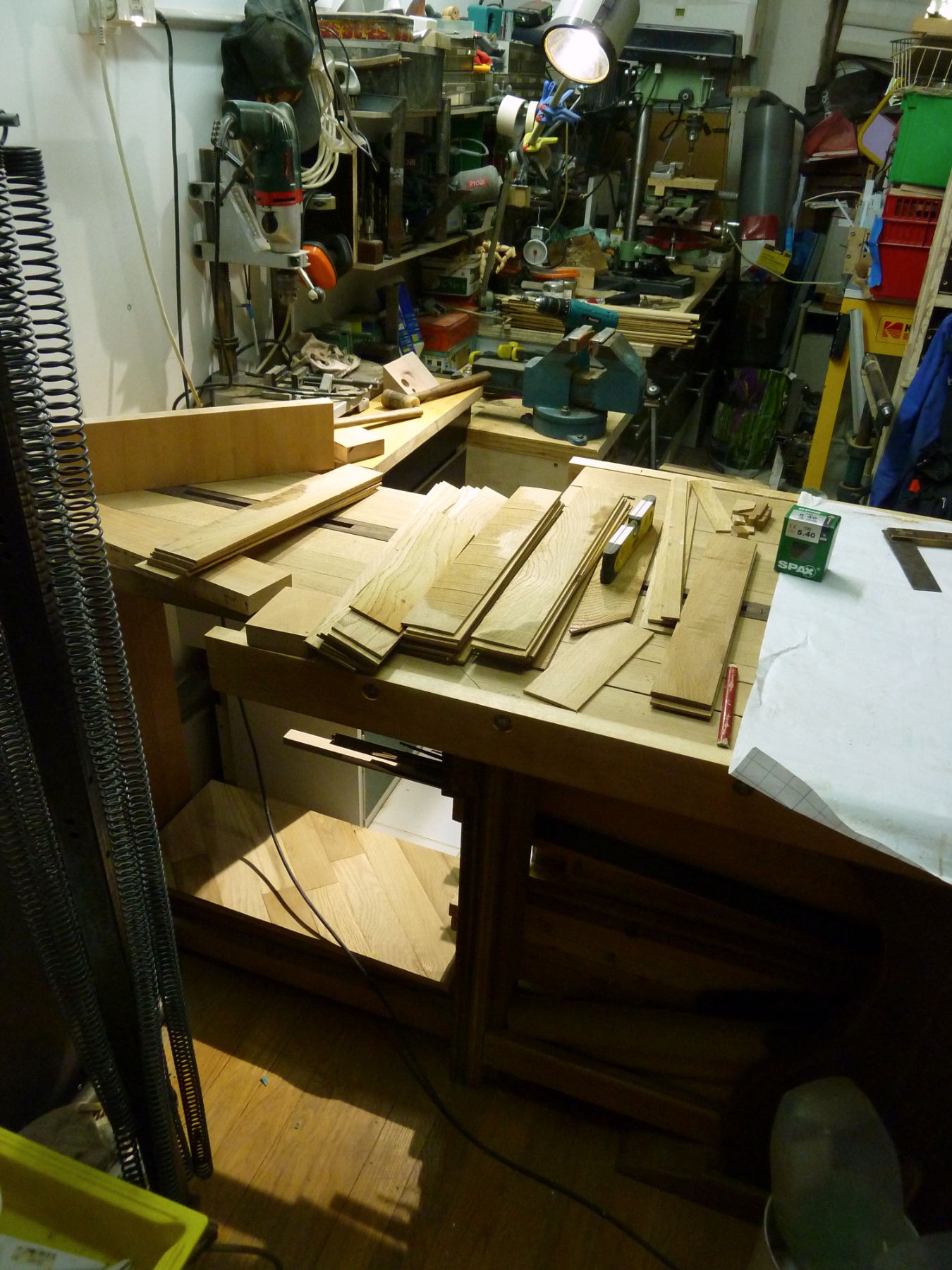
From the back. The shelves not only are practical for storage, but they also add some strength to the rear end of the build, hardening the link between the two legs in the middle and the two ones on the back, crucial.

An important thing, it's not a "P", it just happens that there where not much of that 23 mm oak wood floor after all that, and it's about the shape needed.

One nice drawer slider, some stainless steel M 6 screws and brass inserts.
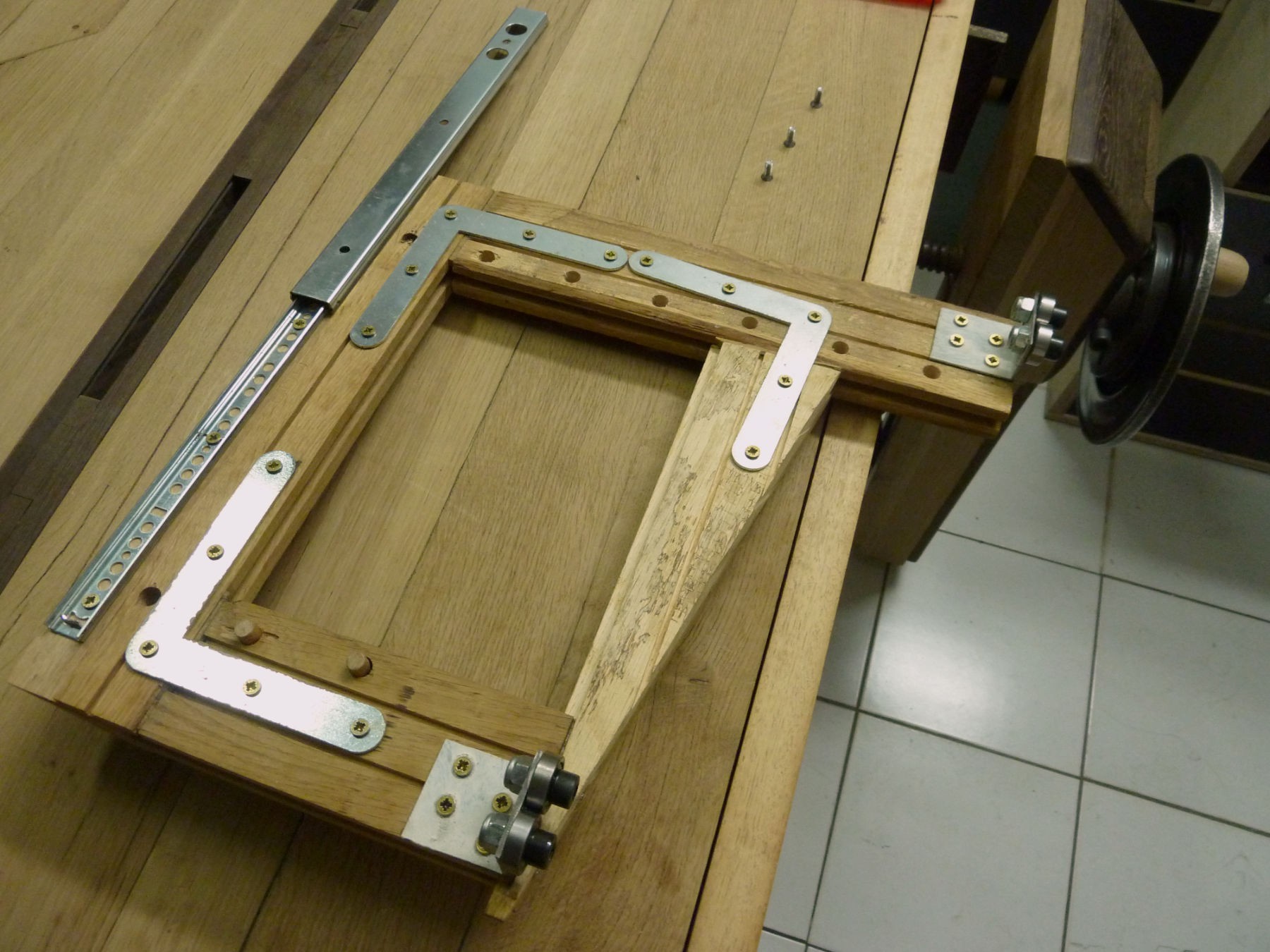
the back of the assembly, the slider on top (left on the picture) and roller bearings on two brackets down (right down and top of the picture).
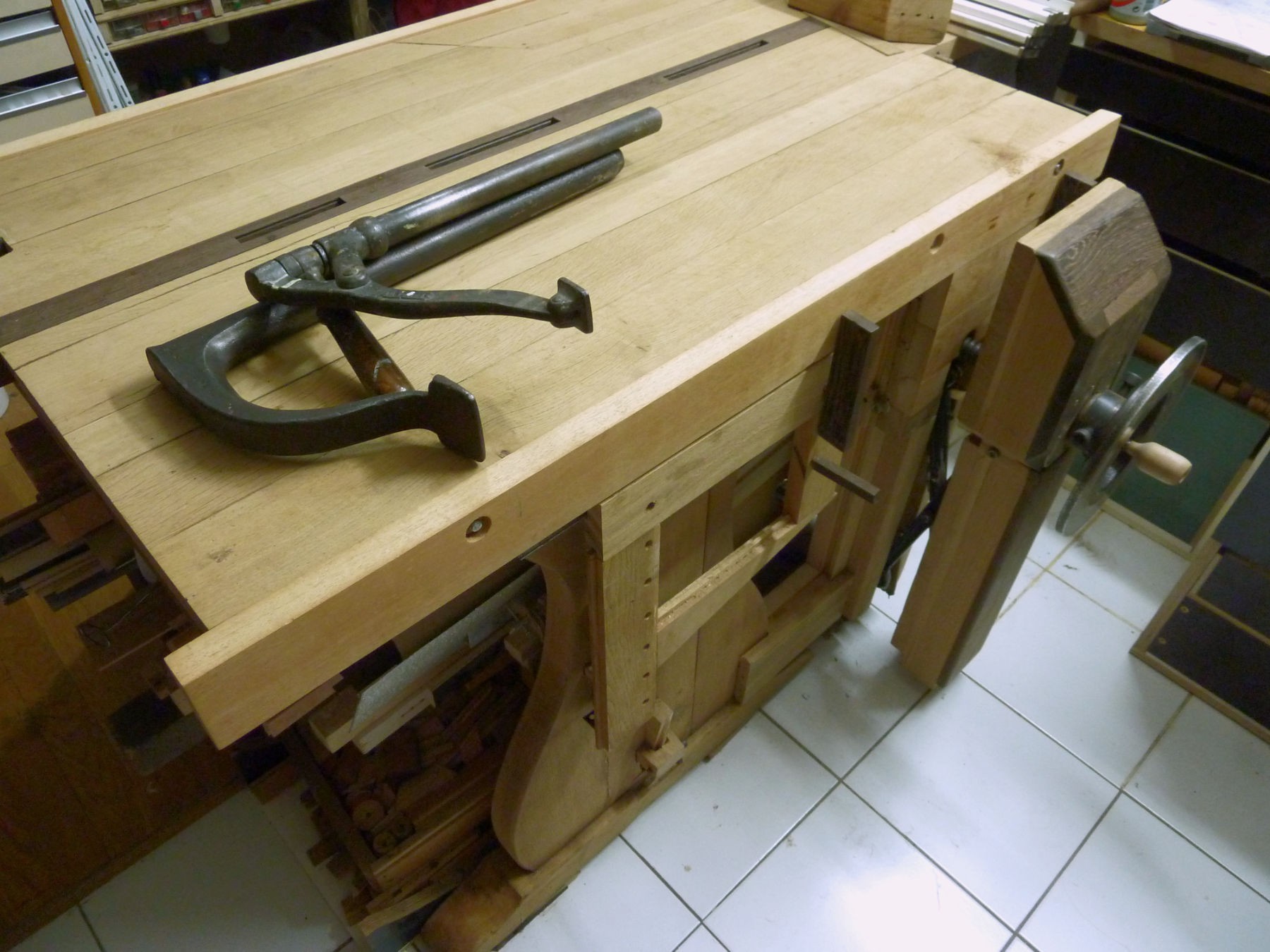
The thing that's not a "P" is a slider for stock holder : when the stock's heavy, you need two hands to hold it, and then, you can lay it down the little wengue pieces on both sides of the jaws, then it's possible to close the wise with the stock already parallel to the bench top, with two free hands.
And now, I need to drill big holes in my bench, for the valets.
The one brought with the lead screw is 32 mm so I'll drill 35 mm holes.

The first holes are good at 230 mm from the edge, the length of the valets heads.
And I thought that 10 cm would be good between 2 holes so I wrote the first one with the roller and the compas.
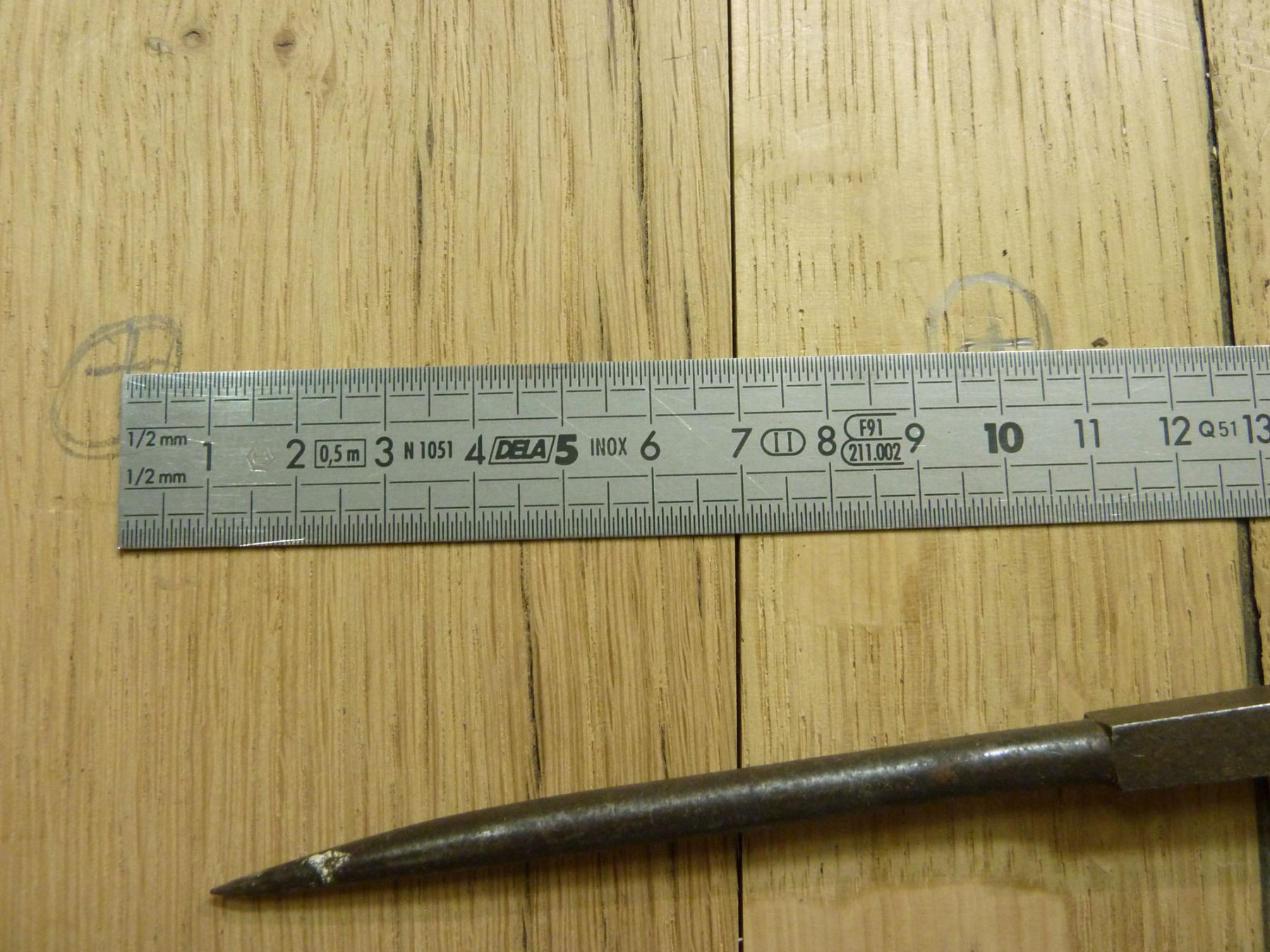
And wrote the second hand held, to see... and it wasn't 99 or 101 mm between the two marks, but exactly 100 !
I like very much those moments : you want the center, put the finger, then use the ruler, the caliper, and it's there...

First hole, makes a lot of chips !
You can see that there's no more room under the bench as its used for medium size wood stock storage.
It adds weight to the bench, and that's good as it must be the heavier possible.
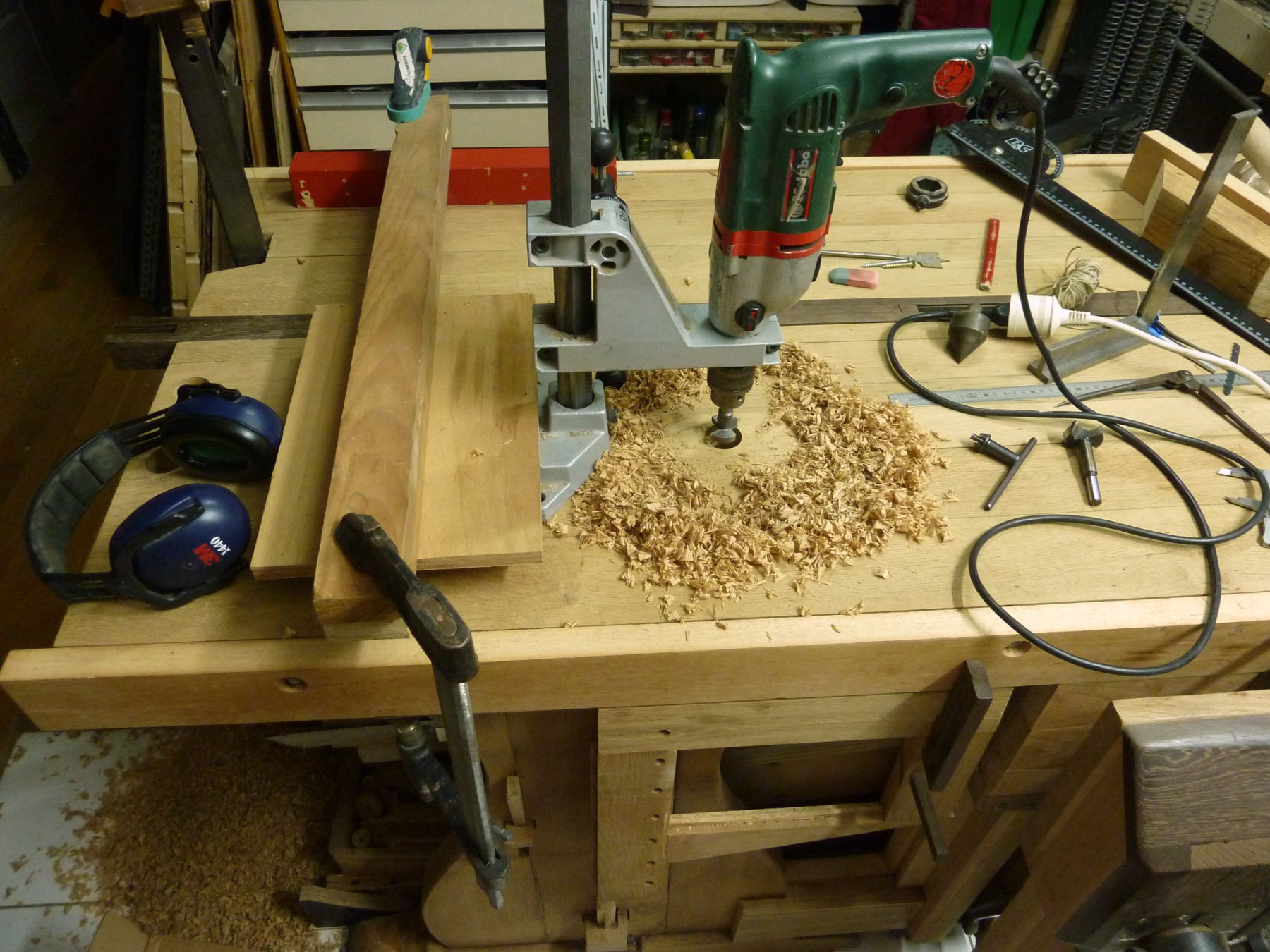
Of course it's not handheld ! the drill holding press must be tightly held on the bench top to have a strait hole.
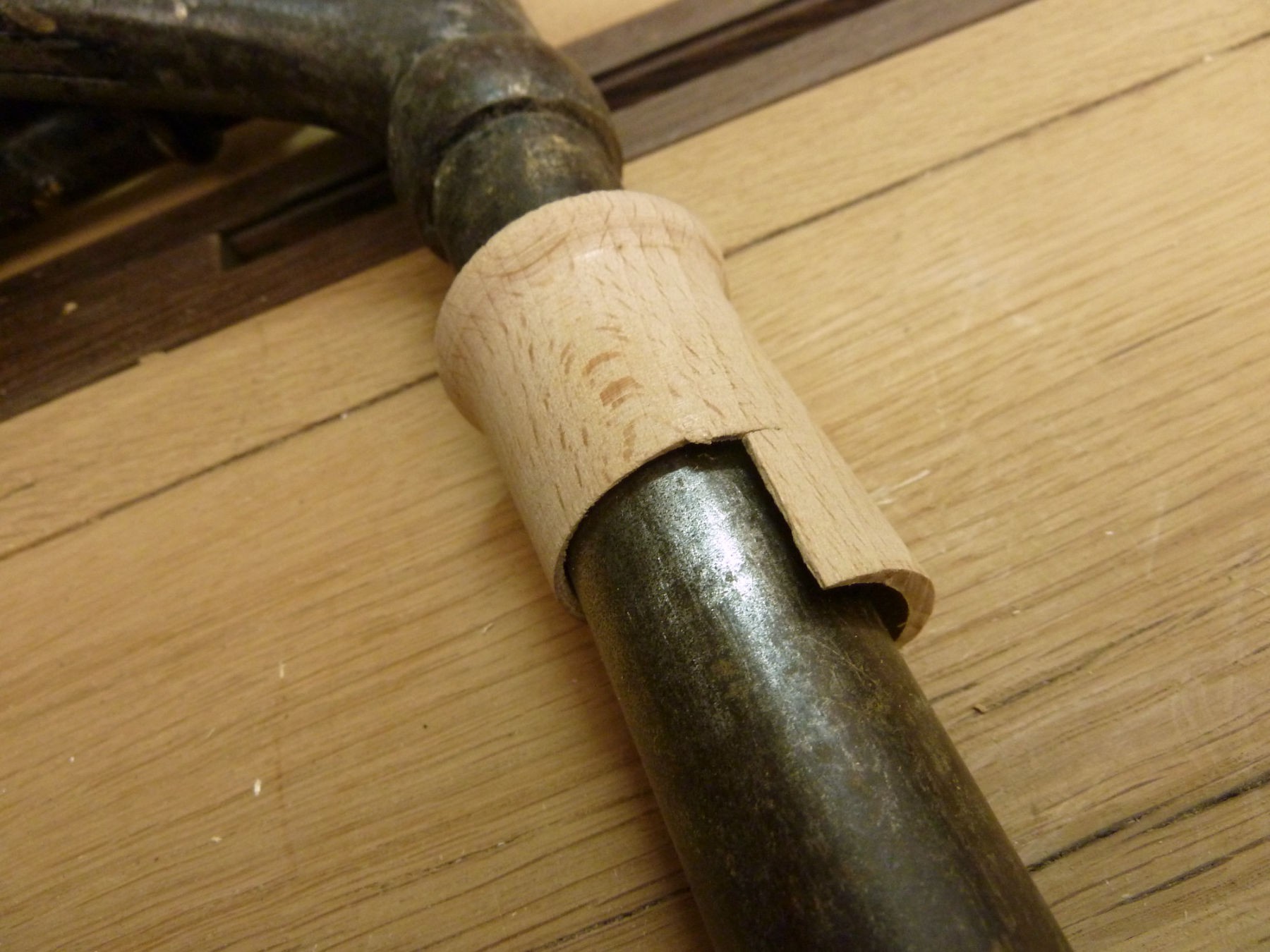
The articulated valet has a smaller diameter than the à frapper (to hit) one, so it needs a sleeve, that one in beechwood made on the drill press didn't last long.
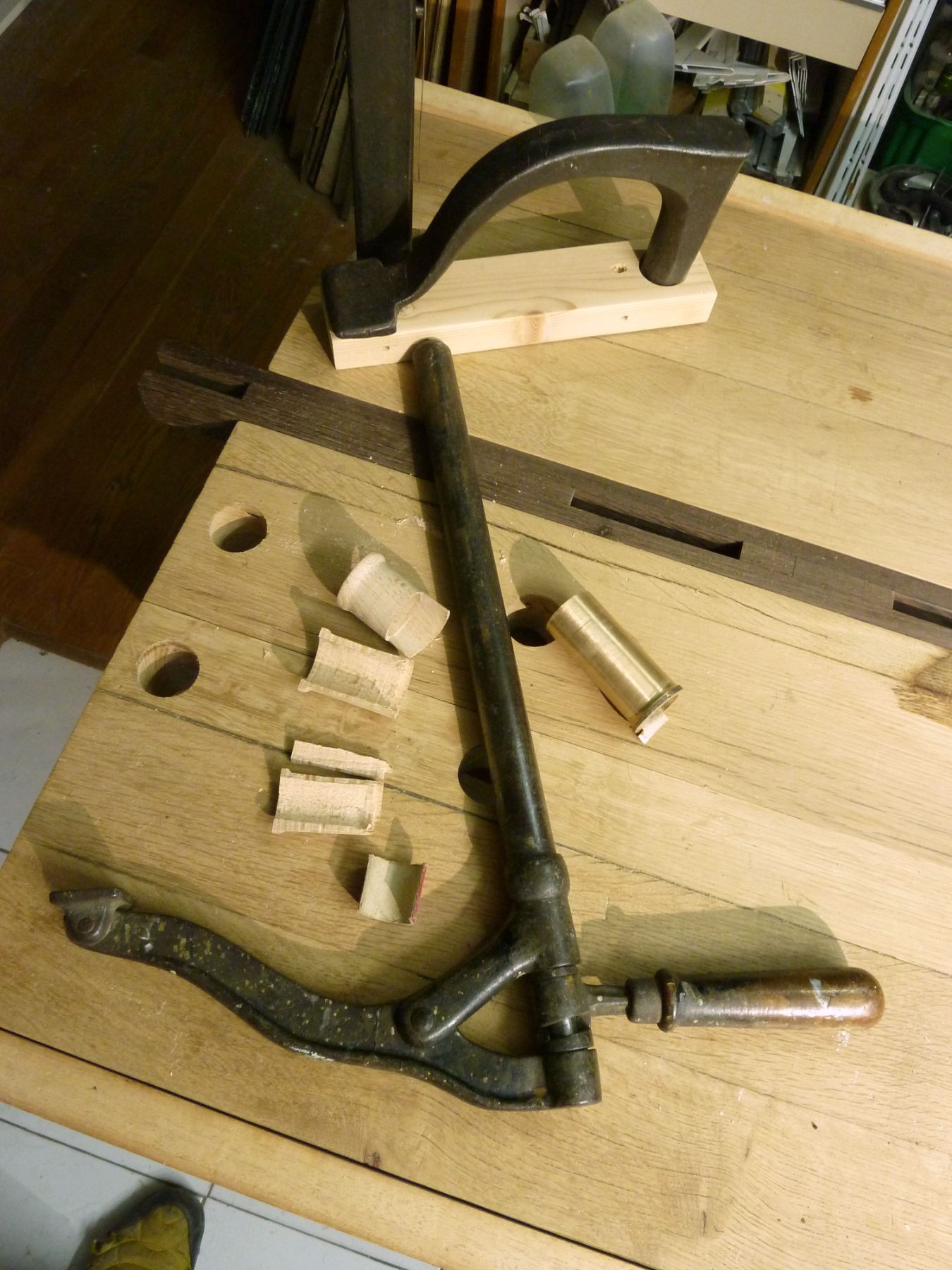
Neither the second one, so I made it from a brass rod on the school's lathe.

It's far from perfect, the old lathe has been worn out by generations of art students, but for my purpose, it's better if it doesn't slip well. The sandpaper is necessary between the valet and the sleeve, as brass is auto lubricant, it's too slippy, the normal steel valet/wood bench has more friction, so it works.
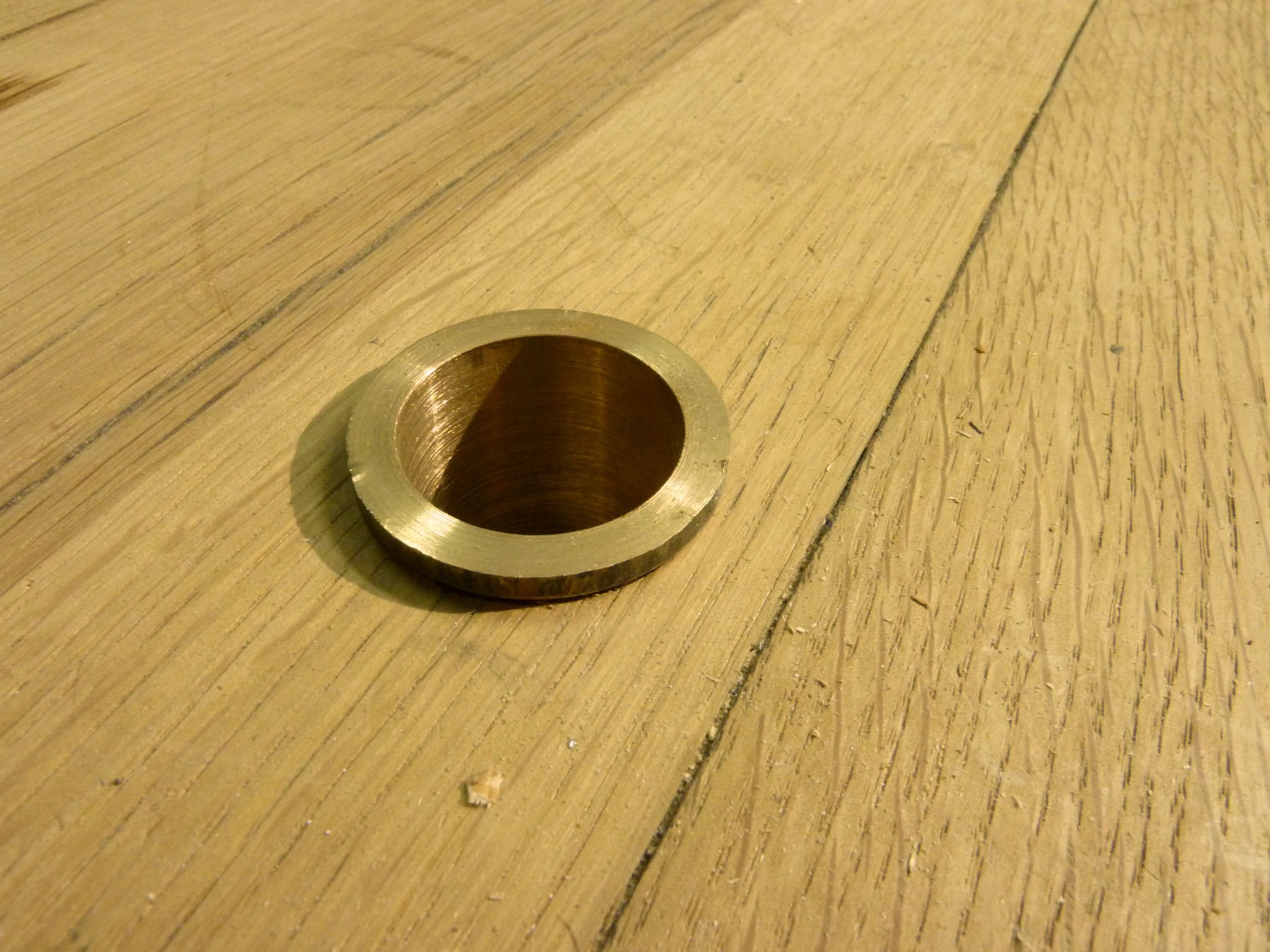
Fits perfectly.
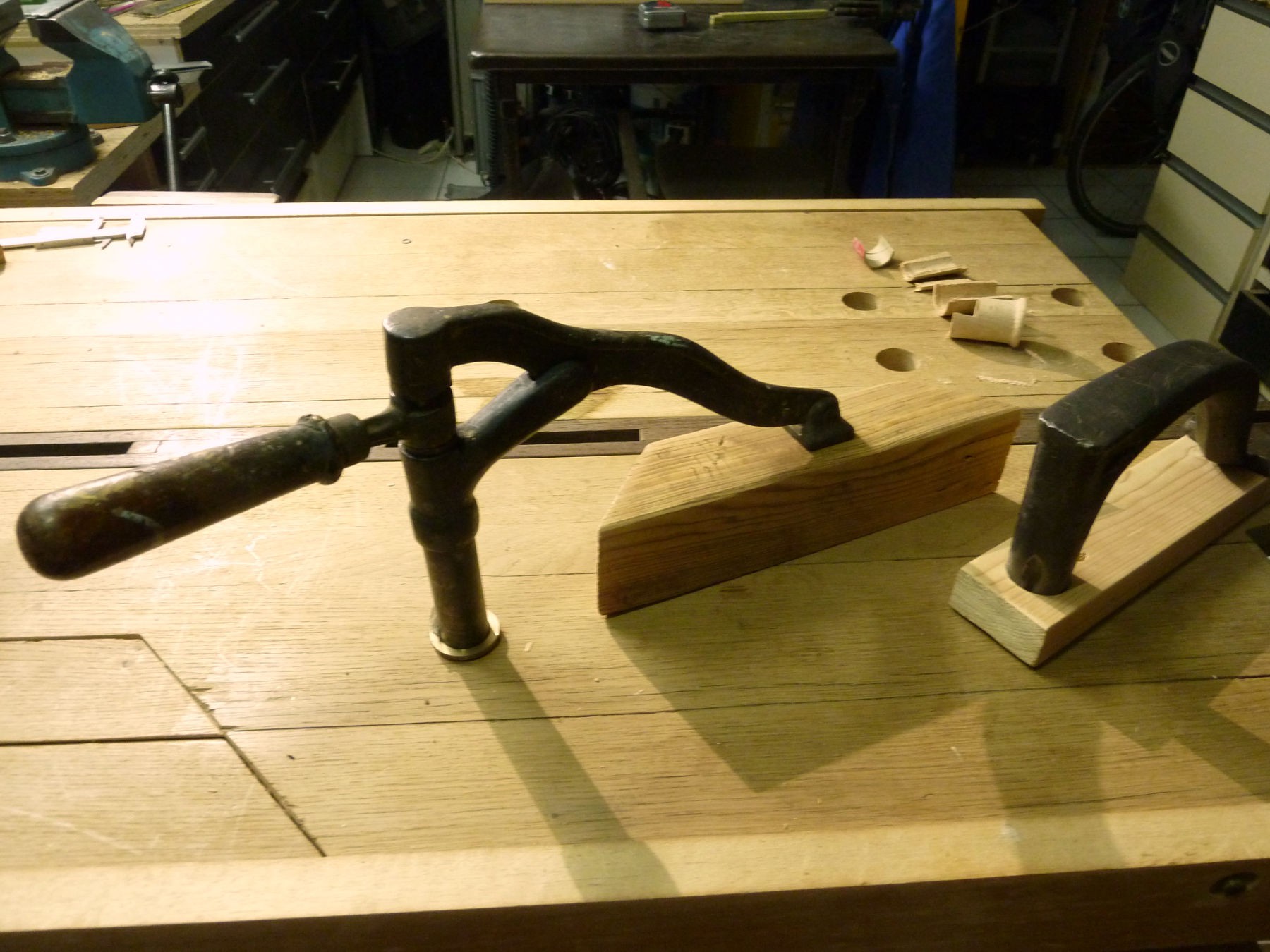
Now I got a very strong stock holder.
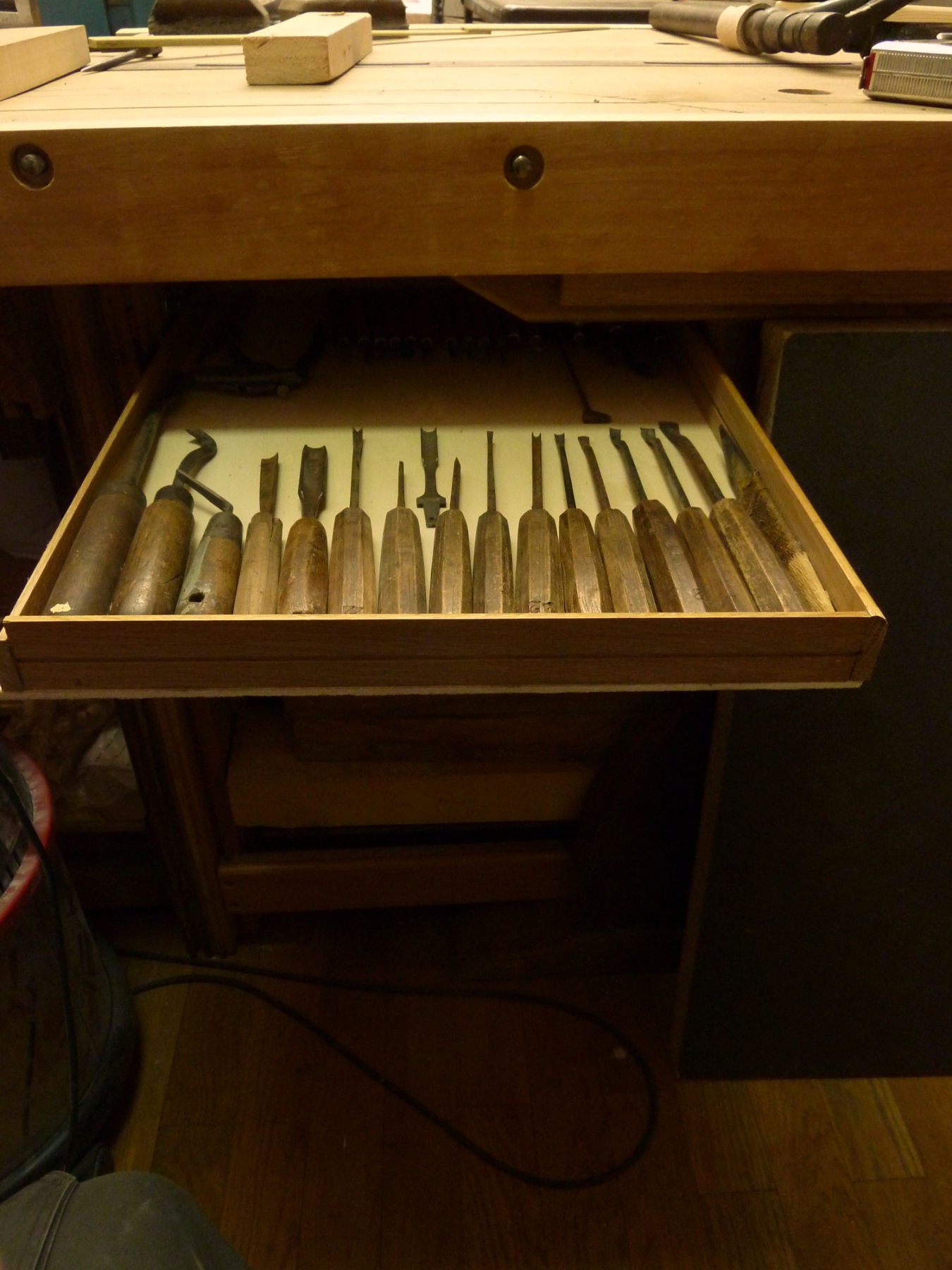
There are 3 small drawers under the upper of the vise opposite side, convenient for small tools storage.
 [zit] Olivier Gade
[zit] Olivier Gade